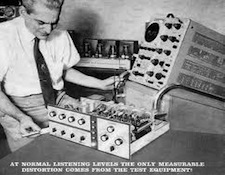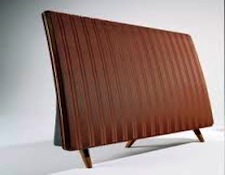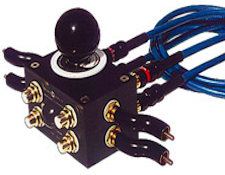It’s the time of year for saving money!
 Stewart Hegeman, who designed the original Harman Kardon Citation line of electronics and one of the first omnidirectional speakers (for Eico) is credited with coming up with the saying, “A straight wire with gain.” I’ve always understood it to mean that the ultimate goal of a high-performance audio system was to sound as if the music was passing through nothing except a wire and some way to control gain. Of course when Hegeman came up with this expression it was assumed that wire didn’t do anything to the sound. Over the subsequent years we have been found that even wire has some influence on how things sound. Some would even say a BIG influence.
Stewart Hegeman, who designed the original Harman Kardon Citation line of electronics and one of the first omnidirectional speakers (for Eico) is credited with coming up with the saying, “A straight wire with gain.” I’ve always understood it to mean that the ultimate goal of a high-performance audio system was to sound as if the music was passing through nothing except a wire and some way to control gain. Of course when Hegeman came up with this expression it was assumed that wire didn’t do anything to the sound. Over the subsequent years we have been found that even wire has some influence on how things sound. Some would even say a BIG influence.
But I’ve noticed that some audiophiles see “straight wire with gain” as a rallying cry to find, buy, or build audio gear with the simplest circuitry, least number of parts, and shortest possible signal path. And while I’ve heard some gear with very simple circuits that sounded great, such as the Nelson Pass designed single-ended class-A power amplifiers, generally the very simple systems I’ve experienced are good, but not great, because they usually don’t handle frequency extremes as well as they handle the midrange.
 But for some people a great midrange trumps all other considerations – hence the number of Quad ESL57s still in service. I’ve owned QUAD ESL 57s, and except for a few “magical” combinations, such as pairing them with Marantz Model 9s in triode mode, getting any sort of bass extension will require a crossover, subwoofers, and the other stuff (like extra cabling) that goes along with adding subwoofers. That is not a simple system. And if you want some high frequency extension you wind up with something akin to an HQD system, which is decidedly more complex than the basic Quad ESL57 system you started out with.
But for some people a great midrange trumps all other considerations – hence the number of Quad ESL57s still in service. I’ve owned QUAD ESL 57s, and except for a few “magical” combinations, such as pairing them with Marantz Model 9s in triode mode, getting any sort of bass extension will require a crossover, subwoofers, and the other stuff (like extra cabling) that goes along with adding subwoofers. That is not a simple system. And if you want some high frequency extension you wind up with something akin to an HQD system, which is decidedly more complex than the basic Quad ESL57 system you started out with.
So for most practical purposes the expression “straight wire with gain” is an ideal or a concept, not a design recipe. But how do you tell how close you’ve gotten to this ideal? Simple – you do A/B bypass tests. J. Gordon Holt was very big on A/B bypass tests. And what is an A/B bypass test? It’s a listening test where you can easily insert and then bypass a component in the signal chain. The ultimate goal is that you hear absolutely no difference when the component is in the signal chain verses when it has been bypassed. As I’ve learned over the years, very few preamps or cables pass this test.
]]> Setting up a bypass test can be pretty easy if you have a tape loop (which is how we used to do it in the old days). You merely put a preamp (for instance) into the tape loop and then switch it into and out of the signal chain. As you can well imagine, very few components ever completely passed JGH’s bypass tests.
Setting up a bypass test can be pretty easy if you have a tape loop (which is how we used to do it in the old days). You merely put a preamp (for instance) into the tape loop and then switch it into and out of the signal chain. As you can well imagine, very few components ever completely passed JGH’s bypass tests.
About ten years ago David Salz of Wireworld designed and built something he called “The A/B comparator” for doing bypass tests on cables. It even had an X setting where it chose whether you were listening to bypass or the cable in the circuit. I had one that I used for a couple of years before I returned it to him. It made me crazy and proved that cables did, indeed, sound different.
While the goals of high-performance audio are the same as they were 60 years ago – to do as little to alter the harmonic, dynamic, and spatial characteristics of the original signal as possible, the way that is accomplished has changed over the years. And while some might argue that we have only gone sideways instead of forward (which I would dispute) even the most contentious audiophile or audio critic can agree that we still haven’t gotten “there” yet.





